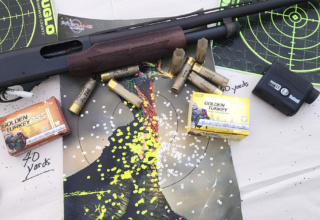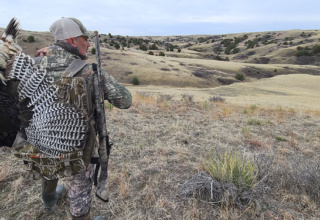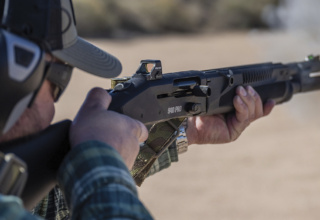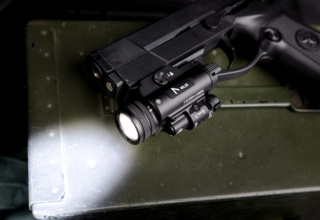With a short turkey season and limited time to hunt, you can’t afford to stay indoors when the weather turns south. Here are our tips for working through the challenge.
by Larry Case
I knew the editor was ticked, and to make it worse, he was ticked at me.
“Whaddya mean you can’t do this story?” he hissed, “I thought you are a turkey hunter!”
“Boss, I am a turkey hunter, I just don’t like the title. You just can’t beat the odds on bad-weather turkeys. They are hard enough to hunt in good weather!”
He growled something about, “Just get me the story,” and the phone went dead.
Oh, the life of the outdoor writer…
Story book sunrises and bluebird days are not always the rule when spring gobbler hunting. Some years, they seem to be the exception. Most of us don’t have the luxury of hunting every day, bell to bell, so we must take advantage of every minute we can get in the turkey woods. Although not ideal conditions, rain, cold, wind, and snow can be dealt with.
Many years ago, I was in turkey camp with some of my Georgia hunting buddies on a cold, rainy morning. I watched as one of them calmly tied his boots, whistling softly to himself. You would have thought it was going to be 65 degrees and sunny. I said, “What are you so happy about? It is nasty out there!” He looked up at me and said, “Cod, the turkeys are out there, rain or shine. They don’t go in a hole when it’s wet.”
Well, you can’t argue with that kind of logic
So, gather round class and your humble outdoor scribe will try to give sage advice for those days when you would rather stay in bed but your better angel screams, “Get your hide up and get out there!”
Rain

Rainy, dreary weather can be the most common weather to deal with in the spring. Some turkey hunters take a rainy morning as a blessing and sleep in, and sometimes that is not a bad idea. Weather predictions these days are not always perfect (yeah, they never were), but if the weatherman is telling you rain will fall until ten o’clock or so and then clear off, stay in bed and be there to greet that gobbler when the sun comes out. Sunny skies after a period of rain will generally trigger some turkey activity, and you should hear some gobbling.
If you are faced with rain most of the day, there are a few options that may work for you. Intermittent showers are certainly better than an all-day deluge, so find a place to hole up while it is raining—such as an old barn, a rock outcropping, or whatever works—and then sally forth to deal with the gobblers when the clouds part. If rain persists most of the day, you must decide how mad you are at the turkeys and go for it.

Turkeys will often go to fields and open areas when it rains. We think they do this because they are less likely to fall victim to a predator attack when they’re out in the open. Steady rain will have all the leaves and low vegetation moving with each raindrop and that ruckus, we believe, could mask the approach of a fox, bobcat, or coyote. Whatever their reasons may be, turkeys will go to the fields in wet weather. Sneak up on open fields to observe if turkeys are present. Once you spot them here, you are dealing with the famous field turkey and all their charms, but at least you are in contact with a gobbler.
Skulking around in the rain with the possibility of belly crawling calls for some good rain gear and boots, so be prepared.
If you are in the middle of a monsoon for the day, there is another option that we did not have back in the day, and that is a ground blind.

Once upon a time, I was more than a little skeptical when I entered a ground blind. I was quickly educated and amazed at how a wary old gobbler would come around this strange bit of cover that was not there the day before. In truth, it astounds me still, but the point is, ground blinds work, and they get you out of the weather. Set up and take down is quick for turkey-specific models like the ALPS OutdoorZ Deception Low-Profile blind. They are not overly heavy to carry, and you can sit in comfort during a deluge. I like to think that, for once, I am more comfortable than the turkey, and the blind makes up for a multitude of sins in the movement department—things that you would never get away with while sitting out in the open. It is also great for kids and newbie turkey hunters.
While we are talking about gear on rainy days, a red dot style optic on the shotgun can be helpful any time, but especially during dreary, low visibility conditions. An optic rids you of that old demon “raising your cheek off the stock to look at the turkey”. This has spared more turkeys than bad calling or bad weather ever did. The fact is, if the dot on the optic is sighted in correctly, wherever you place the dot is where the shot pattern is going. It makes no never mind where your cheek is positioned. This is not the case if you are looking at the bead on a shotgun without an optic.
TRUGLO’s RED•DOT 30mm Dual Color Single Reticle can be just the ticket for a turkey gun. This sight features a 5 MOA reticle for easy viewing and precise aiming, a 30mm objective lens for a wide field of view that’s parallax free from 30 yards, digital push button controls, is water and shock resistant, and operates on a single CR2032 battery. The choice of the red or green dot can be helpful in different light conditions. Remington didn’t put the latest version of this optic on its V3 Turkey Pro model for nothing. It’s a solid optic that works in the turkey woods.
Cold and Snow
In many parts of the country, cold temperatures and sometimes snow are not uncommon in the spring gobbler season. A clear, cold morning may bring you gobbler music galore or they may shut up and treat you like they owe you money. (Turkey fact note: No one this side of heaven knows why turkeys gobble one morning and not another.) If turkeys are silent on a cold morning, you may use the same tactic as the rainy day and simply take a listen after things warm up. There can be a lot of difference between sunrise and ten o’clock as far as temperatures go. Dealing with cold temps may involve simply dressing for the weather and waiting the gobblers out. Sitting quietly and calling occasionally may be all that is required to lure in the gobbler. Don’t forget—if a turkey seeks you out, he may very well come in silent, so be still and stay alert. Here again, the ground blind can work wonders.
Snow can present its own problems but, in short, I have found that turkeys often pay little attention to snow on the ground. If there are only a few inches on the turf, gobblers will usually walk around in it, strut, and go about their daily routine. When you think about it, they don’t have much choice in the matter. Falling snow will be a different matter, depending how heavy it is. Light snow may not affect an ardent turkey that much.
Wind
Of all the bad weather we encounter when turkey hunting, I personally detest wind the most. Robust wind affects all game. Deer, turkeys, squirrels, or whatever don’t seem to move much in the wind and it certainly complicates hunting anything. As noted with rain, everything in the woods is moving and this makes game wary. To make things worse, it is hard to hear anything, and hearing may be the turkey hunter’s greatest weapon.
Having said all this, last season I had a run-in with a gobbler on what had to be one of the worst days to hunt I can remember (or so I thought). The wind was roaring before daylight. As a buddy and I left the truck, we gave each other a look like, “Are we going to do this?” About an hour in, I made a call as we walked a ridge and was amazed to hear a gobble close by. We quickly found sitting positions and the turkey responded closer, this time directly down the hill from us. I thought we might quickly seal the deal.
For reasons known only to the gobbler, he never showed, but the point is we had a close encounter with a turkey on a day when we came close to never getting out of the truck.
It may go without saying that you need to up the volume of your calling on a windy day. Some calls just seem to cut the wind better. A loud, raspy box call may get a response when soft calling on a diaphragm will not. I have long been an advocate of the tube call and have found I can blast a message into the wind with one.
Bad weather in the spring can be a fact of life. It all comes down to this: are you going to hunt or not? Remember, you are not going kill any old gobblers on the couch. Wear the right clothes, get the right gear, and get out there. I was told long ago that turkeys don’t go in a hole.



















